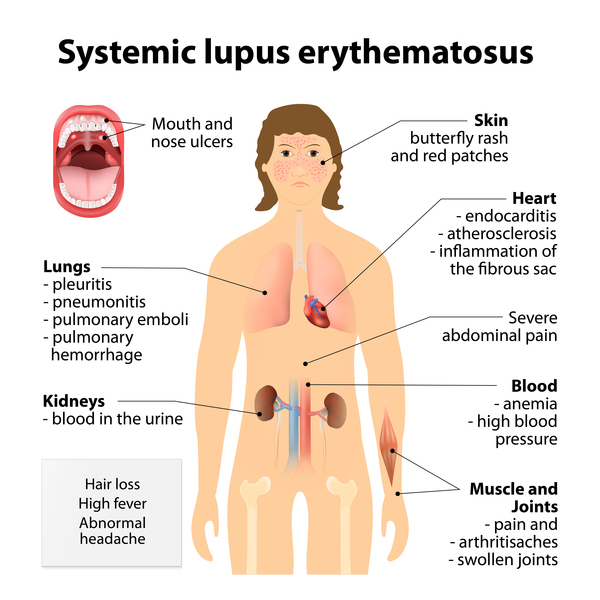Page Contents
- 1 WHAT IS IT?
- 2 WHAT CAUSES IT?
- 3 WHY IS IT A PROBLEM?
- 4 WHAT MAKES US SUSPECT IT?
- 5 HOW DO WE CONFIRM A DIAGNOSIS?
- 6 HOW DO WE RULE OTHER DIAGNOSES OUT?
- 7 HOW DO WE TREAT IT?
- 8 HOW WELL DO THE PATIENTS DO?
- 9 WAS THERE A WAY TO PREVENT IT?
- 10 WHAT ELSE ARE WE WORRIED ABOUT?
- 11 OTHER HY FACTS?
- 12 ARCHIVE OF STANDARDIZED EXAM QUESTIONS
- 13 FURTHER READING
WHAT IS IT?
Systemic lupus erythematosus (SLE) refers to a a multi-system autoimmune disorder of connective tissue that has a highly variable clinical presentation, disease course, and prognosis.
WHAT CAUSES IT?
The exact etiology of SLE is very unclear, however it is characterized by the presence of auto-antibodies that target nuclear antigens within the cells of the body.
WHY IS IT A PROBLEM?
This type of widespread auto-immune destruction of cells/tissues can lead to a very wide range of possible complications for patients (explained more below).

WHAT MAKES US SUSPECT IT?
Risk factors
Female sex, african descent
Initial Presentation
Common Chief Complaints:
- Rash
- Joint pain
- Fever
Raynaud phenomenon may also be caused by SLE
History Of Present Illness
Physical Exam Findings
HEENT exam can reveal:
- Malar rash
- Discoid rash
- Oral/nasopharyngeal ulcers
HOW DO WE CONFIRM A DIAGNOSIS?
Complement levels are decreased (C3,C4) and total complement activity (CH50) is also reduced. This is because of immune complex formation.
Serologies can reveal the presence of the following antibodies:
- Anti-nuclear antibodies (ANA): these are antibodies directed against the nucleus of cells. Sensitive but not specific for SLE.
- Anti-dsDNA antibodies: these are antibodies that are crafted against double stranded DNA. Specific, poor prognosis.
- Anti-Smith antibodies: these target snRNPs. Sensitive but not prognostic
HOW DO WE RULE OTHER DIAGNOSES OUT?
HOW DO WE TREAT IT?
HOW WELL DO THE PATIENTS DO?
WAS THERE A WAY TO PREVENT IT?
WHAT ELSE ARE WE WORRIED ABOUT?
Death: mortality in SLE is often caused by
- Cardiovascular disease
- Infection
- Renal disease
Endocarditis: SLE can cause Libman-Sacks endocarditis. This is characterized by non-bacterial wart-like vegetations on both sides of the heart valves.
Renal disease: SLE can cause both nephritic (diffuse proliferative glomerulonephritis) and nephrotic (membranous glomerulonephritis) kidney damage.
Neurological disorders such as seizures and psychosis can be caused by SLE.
OTHER HY FACTS?
VDRL false positives can be caused by SLE
ARCHIVE OF STANDARDIZED EXAM QUESTIONS
This archive compiles standardized exam questions that relate to this topic.
FURTHER READING
Page Updated: 07.23.2016